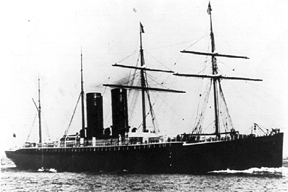SS Oregon (1883)

Guion's Oregon of 1883
|
|
| History | |
|---|---|
|
|
|
| Name: | SS Oregon |
| Operator: |
|
| Builder: | John Elder & Company, in Govan, Scotland |
| Launched: | 23 June 1883 |
| Fate: | Sank in 1886 after a collision with a schooner 18 nautical miles (33 km) East of Long Island, New York |
| General characteristics | |
| Class and type: | Steam passenger ship |
| Tonnage: | 7,375 gross register tons (GRT) |
| Length: | 521 ft (159 m) |
| Beam: | 54 ft (16 m) |
| Propulsion: | Compound steam engine geared to single screw |
| Sail plan: | Four masts with emergency sails |
| Speed: | 18 knots |
| Capacity: | 1432 passengers in three classes |
The Oregon was a record breaking British passenger liner that won the Blue Riband for the Guion Line as the fastest liner on the Atlantic in 1884. She was sold to the Cunard Line after a few voyages and continued to improve her passage times for her new owner. In 1885, Oregon was chartered to the Royal Navy as an auxiliary cruiser, and her success in this role resulted in the Admiralty subsidizing suitable ships for quick conversion in the event of a crisis. She returned to Cunard service in November 1885 and four months later collided with a schooner while approaching New York. All persons on board were rescued before Oregon sank. Her wreck, 18 miles east of Long Island, remains a popular diving site.
The Arizona and Alaska only allowed Guion to schedule fortnightly sailings with express liners in each direction. On alternate weeks, Guion's sailings used ships that were considerably slower. Guion needed two additional Atlantic greyhounds for a balanced weekly service. When Cunard started to build a new fleet for its weekly Liverpool - New York express service, Guion Line ordered Oregon to retain the Atlantic records won by Alaska. As her predecessors, Oregon was built at the Fairfield Yard of John Elder & Company of Glasgow, Scotland, and cost $1,250,000.
Oregon was 6.5% larger and 4 feet wider than Alaska, but the same length to reduce her ratio of length to beam and address the serious vibration problem experienced by Arizona and Alaska. Consideration was given to building Oregon of steel after the fisaco of the City of Rome, but the new metal was still expensive and hard to obtain. Oregon was the last iron record breaker. She had nine transverse watertight bulkheads, five iron decks, and a strong turtle-back deck forward and aft as a protection from the heavy seas.
The compound steam engine built for Oregon had a 70-inch-diameter (1,800 mm) high-pressure cylinder flanked by two 104-inch-diameter (2,600 mm) low-pressure cylinders. The engine generated 12,500 indicated horsepower as compared to 8,300 for Alaska. Steam was generated from nine Fox patent double-ended boilers, each 16 3⁄4 feet long and 16 1⁄2 feet in diameter. Daily coal consumption was 300 tons, an increase of 50 tons compared to Alaska and 165 tons over Arizona. The screw propeller was twenty-four feet in diameter with a shaft that consisted of fifteen separate parts made of crucible steel.
...
Wikipedia
